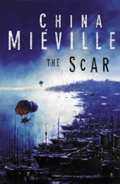1. Beginnings
I sometimes think, wouldn’t it be great to have a Stephen King-size reputation, so you could be sure a reader wouldn’t give up on your novel if the first 50 pages weren’t instantly attention-grabbing. Then you could take a long view and build up towards the really big events later.
China Miéville gets away with it somehow—the important action barely moves forward in the first 200 pages of Perdido Street Station or The Scar.  I’d have given up except that friends had told me. ‘You must read this’—and they were right. The slow set-up pays off wonderfully when those two novels finally shift into massive action. For most genre writers, though, the fast grab is a practical necessity. I’d have given up except that friends had told me. ‘You must read this’—and they were right. The slow set-up pays off wonderfully when those two novels finally shift into massive action. For most genre writers, though, the fast grab is a practical necessity.
It’s not easy when the reader doesn’t yet care about the characters or understand the context. What’s needed is the kind of action that can be immediately, generally exciting.
In the first chapter of Worldshaker, Col is woken up in the middle of the night when two warrant officers burst into his cabin, wielding batons, searching for a renegade. After they’ve left, Col suddenly thinks to look under his bed—and there she is, wide startled eyes peering out at him. I think it manages to be exciting even though the reader doesn’t yet know that this is all happening in a world that’s hugely different from our own. In fact, Col’s cabin is a cabin in a juggernaut, not a ship, and the renegade girl is fleeing from something unthinkable in our own reality.
It wasn’t always like this. In the 19th century, when novels didn’t have to compete with a hundred other claims on our attention, they typically began with a slow zoom and pan. The reader would be introduced to the locale (‘a small village, not sixty miles from London’), the protagonist’s family (‘had lived in X Street for a hundred years … held in wide respect’), then gradually bringing forward the protagonist by way of upbringing, customary activities and so on. 19th Century readers liked their bearings first.
Nowadays, we live in a film world, so we’re used to being pitched headlong into the middle of a scene. We don’t fluster and panic—‘Where are we?’ ‘Who’s that woman?’ ‘Why is she doing that?’ We trust to pick up the situation as we go along.
Even young readers don’t demand to be given a full explanation of the situation first—perhaps less so than older adult readers (though publishers may not agree).

|

